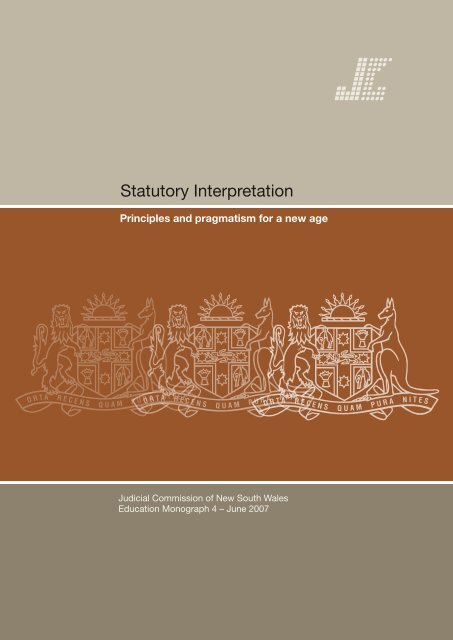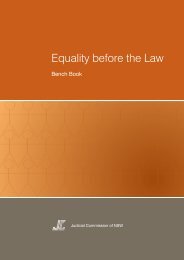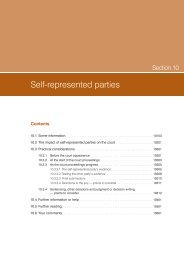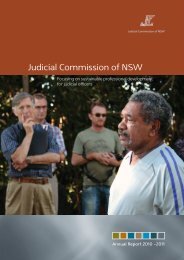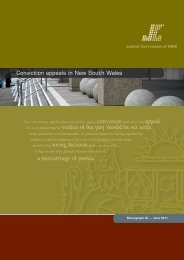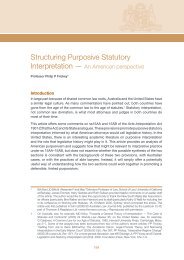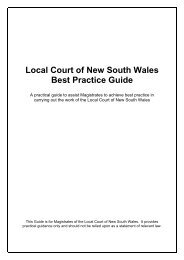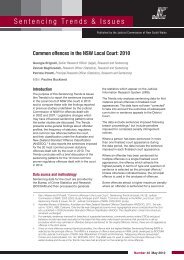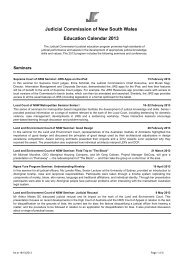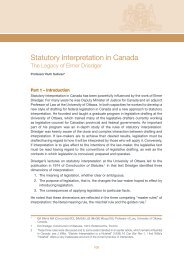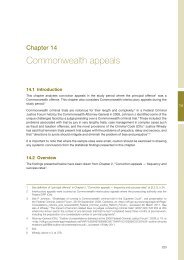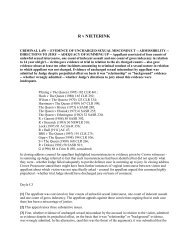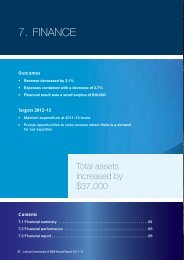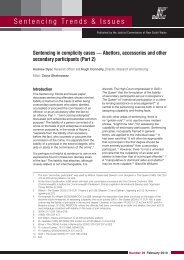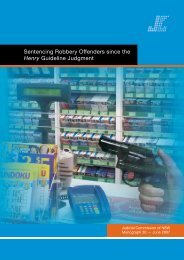Statutory Interpretation - Judicial Commission of New South Wales
Statutory Interpretation - Judicial Commission of New South Wales
Statutory Interpretation - Judicial Commission of New South Wales
Create successful ePaper yourself
Turn your PDF publications into a flip-book with our unique Google optimized e-Paper software.
<strong>Statutory</strong> <strong>Interpretation</strong><br />
Principles and pragmatism for a new age<br />
Education Monograph 4
Published in Sydney by the:<br />
<strong>Judicial</strong> <strong>Commission</strong> <strong>of</strong> <strong>New</strong> <strong>South</strong> <strong>Wales</strong><br />
Level 5, 301 George Street<br />
Sydney NSW 2000<br />
DX 886 Sydney<br />
GPO Box 3634<br />
Sydney NSW 2001<br />
www.judcom.nsw.gov.au<br />
National Library <strong>of</strong> Australia<br />
Cataloguing-in-publication entry<br />
<strong>Statutory</strong> interpretation : principles and pragmatism for a new age.<br />
Includes index.<br />
ISBN 9780731356195<br />
1. <strong>Judicial</strong> process — <strong>New</strong> <strong>South</strong> <strong>Wales</strong>. 2. Law — <strong>New</strong> <strong>South</strong><br />
<strong>Wales</strong> — <strong>Interpretation</strong> and construction. 3. <strong>Judicial</strong><br />
discretion — <strong>New</strong> <strong>South</strong> <strong>Wales</strong>. I. Gotsis, Tom. II. Title.<br />
(Series : Educational monograph (<strong>Judicial</strong> <strong>Commission</strong> <strong>of</strong> <strong>New</strong> <strong>South</strong> <strong>Wales</strong>)).<br />
347.94405<br />
© <strong>Judicial</strong> <strong>Commission</strong> <strong>of</strong> <strong>New</strong> <strong>South</strong> <strong>Wales</strong> 2007<br />
This publication is copyright. Other than for the purposes <strong>of</strong>, and subject to the conditions prescribed under the<br />
Copyright Act 1968 (Cth), no part <strong>of</strong> it may in any form or by any means (electronic, mechanical, microcopying,<br />
photocopying, recording or otherwise) be reproduced, stored in a retrieval system or transmitted without prior<br />
permission. Enquiries should be addressed to the publisher.<br />
The views expressed in this monograph are the views <strong>of</strong> the individual authors and do not represent any<br />
<strong>of</strong>ficial views <strong>of</strong> the <strong>Judicial</strong> <strong>Commission</strong> <strong>of</strong> <strong>New</strong> <strong>South</strong> <strong>Wales</strong>, nor are they necessarily shared by all members<br />
<strong>of</strong> the staff <strong>of</strong> the <strong>Commission</strong>. Whilst all reasonable care has been taken in the preparation <strong>of</strong> this publication,<br />
no liability is assumed for any errors or omissions.<br />
Editor: Tom Gotsis<br />
Graphic design and typesetting: Lorraine Beal<br />
Printed by: Emerald Press
Table <strong>of</strong> contents<br />
Foreword . . . . . . . . . . . . . . . . . . . . . . . . . . . . . . . . . . . . . . . . . . . . . . . . . . . . . . . . . . . . . . . . . . . v<br />
Editor’s Note . . . . . . . . . . . . . . . . . . . . . . . . . . . . . . . . . . . . . . . . . . . . . . . . . . . . . . . . . . . . . . . vii<br />
Statutes . . . . . . . . . . . . . . . . . . . . . . . . . . . . . . . . . . . . . . . . . . . . . . . . . . . . . . . . . . . . . . . . . . . 1<br />
The Honourable WMC Gummow AC<br />
Justice <strong>of</strong> the High Court <strong>of</strong> Australia<br />
The Principles <strong>of</strong> Legality and Clear Statement . . . . . . . . . . . . . . . . . . . . . . . . . . . . . . . . . . 13<br />
The Honourable JJ Spigelman AC<br />
Chief Justice <strong>of</strong> <strong>New</strong> <strong>South</strong> <strong>Wales</strong><br />
The Intent <strong>of</strong> Legislators . . . . . . . . . . . . . . . . . . . . . . . . . . . . . . . . . . . . . . . . . . . . . . . . . . . . . 33<br />
The Honourable Justice Keith Mason AC<br />
President, <strong>New</strong> <strong>South</strong> <strong>Wales</strong> Court <strong>of</strong> Appeal<br />
The High Court <strong>of</strong> Australia and Modes <strong>of</strong> Constitutional <strong>Interpretation</strong> . . . . . . . . . . . . . 45<br />
The Honourable Justice Susan Kenny<br />
Judge <strong>of</strong> the Federal Court <strong>of</strong> Australia<br />
Legislative Drafting and <strong>Statutory</strong> <strong>Interpretation</strong> . . . . . . . . . . . . . . . . . . . . . . . . . . . . . . . . . 81<br />
Ms Hilary Penfold QC<br />
First Parliamentary Counsel<br />
Commonwealth Office <strong>of</strong> Parliamentary Counsel, 1993–2004<br />
<strong>Statutory</strong> <strong>Interpretation</strong> in Canada . . . . . . . . . . . . . . . . . . . . . . . . . . . . . . . . . . . . . . . . . . . 105<br />
Pr<strong>of</strong>essor Ruth Sullivan<br />
Faculty <strong>of</strong> Law, University <strong>of</strong> Ottawa<br />
Purpose and Context in <strong>Statutory</strong> <strong>Interpretation</strong> . . . . . . . . . . . . . . . . . . . . . . . . . . . . . . . . 127<br />
Associate Pr<strong>of</strong>essor RS Geddes<br />
School <strong>of</strong> Law, University <strong>of</strong> <strong>New</strong> England<br />
Structuring Purposive <strong>Statutory</strong> <strong>Interpretation</strong> . . . . . . . . . . . . . . . . . . . . . . . . . . . . . . . . . 159<br />
Pr<strong>of</strong>essor Philip P Frickey<br />
School <strong>of</strong> Law, University <strong>of</strong> California at Berkeley<br />
Saving the Literal . . . . . . . . . . . . . . . . . . . . . . . . . . . . . . . . . . . . . . . . . . . . . . . . . . . . . . . . . . 177<br />
Pr<strong>of</strong>essor James C Raymond<br />
Consultant in Legal Writing and Reasoning<br />
Index . . . . . . . . . . . . . . . . . . . . . . . . . . . . . . . . . . . . . . . . . . . . . . . . . . . . . . . . . . . . . . . . . . . . . 217<br />
Table <strong>of</strong> Statutes . . . . . . . . . . . . . . . . . . . . . . . . . . . . . . . . . . . . . . . . . . . . . . . . . . . . . . . . . . . . 225<br />
Table <strong>of</strong> Cases . . . . . . . . . . . . . . . . . . . . . . . . . . . . . . . . . . . . . . . . . . . . . . . . . . . . . . . . . . . . . . 229<br />
iii
Foreword<br />
Lawyers are traffickers in words. Words are the vehicle by which the law and legal<br />
relationships must be conveyed. Words are our basic tools <strong>of</strong> trade. Interpreting words<br />
is a large part <strong>of</strong> what we do.<br />
Lawyers, including parliamentary draftsmen, attempt to be as precise and clear as<br />
possible and to anticipate the kinds <strong>of</strong> issues that may arise in the course <strong>of</strong> application<br />
<strong>of</strong> legislation. However, clarity and precision can never be capable <strong>of</strong> complete<br />
achievement, not least because the verbal formulae devised in legislative form <strong>of</strong>ten<br />
have to be stretched to factual situations that no-one could have or did anticipate.<br />
Hence litigation about what words mean. As Lord McMillan once put it:<br />
“One <strong>of</strong> the chief functions <strong>of</strong> our courts is to act as an animated and authoritative dictionary.” 1<br />
One <strong>of</strong> the difficulties is, <strong>of</strong> course, the richness <strong>of</strong> our language which gives rise to<br />
ambiguity, indeterminacy or inexplicitness. In English, as in French, in the words <strong>of</strong><br />
Joseph Joubert:<br />
“Words are like eyeglasses, they blur everything which they do not make more clear.” 2<br />
Over the last two or three decades there appears to have been a paradigm shift in all<br />
forms <strong>of</strong> interpretation <strong>of</strong> legal texts, including constitutional, statutory and contractual<br />
interpretation. The shift is from text to context. Literal interpretation — a focus on<br />
the plain or ordinary meaning <strong>of</strong> particular words — is no longer in vogue. Purposive<br />
interpretation is what we do now!<br />
Of course context was always accepted as significant. Sir Owen Dixon, who many<br />
would place at the literalist end <strong>of</strong> the spectrum <strong>of</strong> judicial approaches to interpretation,<br />
said in 1934:<br />
“The rules <strong>of</strong> interpretation require us to take expressions in their context, and to construe them<br />
with proper regard to the subject matter with which the instrument deals and the object it seeks<br />
to achieve, so as to arrive at the meaning attached to them by those who must use them.” 3<br />
Nevertheless, there does appear to have been a change in the emphasis given to context,<br />
by referring to it in the first instance and not simply after some verbal or grammatical<br />
ambiguity has been identified.<br />
Justice Learned Hand explained the approach now generally applied:<br />
“Of course it is true that the words used, even in their literal sense, are the primary, and ordinarily<br />
the most reliable, sources <strong>of</strong> interpreting the meaning <strong>of</strong> any writing: be it a statute, a contract, or<br />
1 Lord McMillan, Law and Other Things, 1937, Cambridge University Press, Cambridge, p 163.<br />
2 J Joubert, Pensées, 1842, Section 21, Part 15.<br />
3 See R v Wilson; Ex parte Kisch (1934) 52 CLR 234 at 244.
<strong>Statutory</strong> <strong>Interpretation</strong><br />
anything else. But it is one <strong>of</strong> the surest indices <strong>of</strong> a mature and developed jurisprudence not to<br />
make a fortress out <strong>of</strong> the dictionary; but to remember that statutes always have some purpose<br />
or object to accomplish, whose sympathetic and imaginative discovery is the surest guide to their<br />
meaning.” 4<br />
However, as Felix Frankfurter once put it:<br />
“While courts are no longer confined to the language, they are still confined by it. Violence must<br />
not be done to the words chosen by the legislature.” 5<br />
The collection <strong>of</strong> essays in this monograph is a testament to the recognition by judges<br />
and legal scholars <strong>of</strong> the central significance <strong>of</strong> statutory interpretation to contemporary<br />
legal practice, including litigation. There is now a widespread acceptance that statutory<br />
interpretation constitutes a distinct body <strong>of</strong> law. As I have said in the paper that is<br />
reprinted herein, many areas <strong>of</strong> law are entirely the creation <strong>of</strong> statute and no area <strong>of</strong> the<br />
law has escaped modification by statute, <strong>of</strong>ten substantial modification. It is perhaps<br />
somewhat ironic that one <strong>of</strong> the areas <strong>of</strong> the law that has been least modified by statute<br />
is the law <strong>of</strong> statutory interpretation. Not least for that reason, the principles <strong>of</strong> statutory<br />
interpretation require the kind <strong>of</strong> detailed attention that appears in this monograph.<br />
The Honourable JJ Spigelman AC<br />
Chief Justice <strong>of</strong> <strong>New</strong> <strong>South</strong> <strong>Wales</strong><br />
4 Cabell v Markham 148 F 2d 737 at 739 (1945).<br />
5 F Frankfurter, “Some Reflections on the Reading <strong>of</strong> Statutes” (1947) 47 Columbia Law Review 527 at 543.<br />
vi
Editor’s Note<br />
Comparing different societies, past and present, it readily becomes apparent that law is<br />
not static but adapts its form to reflect the social, economic and political characteristics<br />
<strong>of</strong> the particular society in which it operates. 1 In Australia today there are over 1000 Acts<br />
in force in <strong>New</strong> <strong>South</strong> <strong>Wales</strong> alone. 2 Our specialised, information-age society requires<br />
an A–Z set <strong>of</strong> specialised, information-age laws — and statute law is the form <strong>of</strong> law that<br />
has evolved to meet this need. 3<br />
Whether on paper or computer screen, statutes make the will <strong>of</strong> those who govern<br />
indelible. Indelible but inert, like all words, until enlivened when read. <strong>Statutory</strong><br />
interpretation — as opposed to statutory declaration, discovery or divination — is a<br />
term that explicitly alludes to the low-fidelity nature <strong>of</strong> reading and writing. 4 A reader<br />
cannot recreate a writer’s intent with the precision <strong>of</strong> copying a digital computer file; nor<br />
can a writer ensure that any particular form <strong>of</strong> words will perfectly transmit their ideas to<br />
all readers. Reading is an analogue process because words are ambiguous, irreducible<br />
to fixed units <strong>of</strong> meaning. As Justice Mason and Pr<strong>of</strong>essor Raymond explain in their<br />
respective articles, this is why dictionaries can do no more than list the various alternative<br />
meanings <strong>of</strong> a particular word and leave it up to the reader to choose which meaning<br />
is appropriate in any given context. It is the judiciary’s ongoing effort to grapple with<br />
the inherent linguistic ambiguity <strong>of</strong> statutes — a specialised exercise in hermeneutics<br />
— that gives rise to the principles and practice <strong>of</strong> statutory interpretation.<br />
It follows that statutory interpretation ultimately endeavours to reduce ambiguity to<br />
background noise, so that meaning becomes discernable. Precisely how this occurs is<br />
examined by the authors <strong>of</strong> the following selected articles. Collecting and juxtaposing<br />
the different perspectives <strong>of</strong>fered by the individual authors — judicial, legislative drafter,<br />
academic, Australian, American, Canadian — adds richness to the insights <strong>of</strong>fered and<br />
provided the rationale for the form <strong>of</strong> this publication.<br />
Justice Gummow draws attention to how, despite much being said in judgments about<br />
purposive interpretation, legislative drafters cannot be released from the requirements <strong>of</strong><br />
precision <strong>of</strong> thought and expression. Purposivism cannot provide determinative answers<br />
1 P Goodrich, Reading the Law, 1986, Basil Blackwell, Oxford, Ch 1 “Ideational and Institutional Sources<br />
<strong>of</strong> Law”.<br />
2 Chief Justice Gleeson has explained that “[i]f you compare the amount <strong>of</strong> legislative output <strong>of</strong> a modern<br />
parliament with the legislative output <strong>of</strong> 100 or 50 years ago, the change is extraordinary.”: “Law is now<br />
too complex for juries to understand”, The Sydney Morning Herald, 26 March 2007.<br />
3 Chief Justice Spigelman has described our time as the “age <strong>of</strong> statutes”, where “no area <strong>of</strong> the law has<br />
escaped statutory modification”: JJ Spigelman, “The Poet’s Rich Resource: Issues in <strong>Statutory</strong> <strong>Interpretation</strong>”<br />
(2001) 21 Australian Bar Review 224 at 224. Justice Kirby has recently highlighted the importance<br />
<strong>of</strong> statute law by describing the common law as “orbiting around” statute law: MD Kirby, “Precedent Law,<br />
Practice and Trends in Australia” (2007) 28 Australian Bar Review 243 at 251. Kirby J has also recently<br />
said that “we have well and truly entered the age <strong>of</strong> statutes [but] … we still need to wean lawyers from<br />
their love affair with the common law”: “Too Rigid, No Bill <strong>of</strong> Rights: Kirby’s Constitution Verdict”, The<br />
Sydney Morning Herald, 19 March 2007.<br />
4 On the nature <strong>of</strong> language and reading, see S Pinker, The Language Instinct, 1994, Harper Collins, <strong>New</strong> York.<br />
vii
<strong>Statutory</strong> <strong>Interpretation</strong><br />
where different purposes, and perhaps cross-purposes, are apparent. His Honour then<br />
refers to a persisting attitude that statute law is less interesting and less important than<br />
“purely judge-made law”. This attitude, <strong>of</strong> English pedigree, begins in law schools, where<br />
students are plied with cases but graduate with few skills in doing what practitioners<br />
do on a daily basis — reading statutes. But the common law contained both “gross<br />
imperfection” and “grand principles”; and, in the newly federated nations <strong>of</strong> Australia<br />
and the United States, legislation enabled the gross imperfections to be eradicated and<br />
the Parliaments to adapt to ever-changing circumstances, including their citizens’ own<br />
evolving values. Justice Gummow then considers the many ways in which the presence<br />
<strong>of</strong> a written federal constitution influences the form and interpretation <strong>of</strong> statute law.<br />
Chief Justice Spigelman explains that statutory interpretation is not merely a collection<br />
<strong>of</strong> maxims, but properly forms a distinct body <strong>of</strong> law. To a substantial degree, common<br />
law protection <strong>of</strong> fundamental rights and liberties now resides within the law <strong>of</strong> statutory<br />
interpretation. His Honour, after discussing parliamentary intent, context and ambiguity,<br />
focuses on one <strong>of</strong> the most fundamental assumptions <strong>of</strong> statutory interpretation — the<br />
principle <strong>of</strong> legality. His Honour quotes Lord H<strong>of</strong>fman, who explained:<br />
“The principle <strong>of</strong> legality means that the Parliament must squarely confront what it is doing and<br />
accept the political costs. Fundamental rights cannot be overridden by general or ambiguous<br />
words”.<br />
Chief Justice Spigelman suggests that the test applied by a court to determine whether<br />
a particular statute has subordinated the principle <strong>of</strong> legality should be known as the<br />
clear statement principle. Nevertheless, “[t]he core difficulty remains. Clarity, like beauty,<br />
always involves questions <strong>of</strong> degree and is affected by the eye <strong>of</strong> the beholder.”<br />
His Honour then demonstrates the potential for friction between the principle <strong>of</strong> legality<br />
and the clear statement principle by examining how courts interpret statutes in cases<br />
where what is at stake is the presumption that Parliament does not intend to interfere<br />
with fundamental rights and freedoms.<br />
Justice Mason points out that the judicial experience <strong>of</strong> legislation is bound to be<br />
jaundiced — the easy issues <strong>of</strong> statutory interpretation are all resolved before they<br />
proceed to court. Judges may also find legislation challenging because, apart from any<br />
real defects contained in an Act, which <strong>of</strong>ten reflect the realities <strong>of</strong> legislative drafting,<br />
legislation challenges ideas and attitudes that have taken over half a lifetime to learn.<br />
His Honour then describes the distinguishing feature <strong>of</strong> modern Australian drafting as<br />
“fussy”, as opposed to the “fuzzy” style <strong>of</strong> the law <strong>of</strong> the past or the European civil<br />
system. Fussy law concentrates on detailed distinctions and specific circumstances,<br />
while fuzzy law is expressed in terms <strong>of</strong> general principles and broad legislative<br />
purposes. Judges need to be able to recognise the different styles <strong>of</strong> law and “change<br />
gear” to interpret provisions accordingly. Justice Mason then discusses developments<br />
in specific interpretive techniques, including the use <strong>of</strong> legislative context and purposive<br />
construction, before suggesting that courts can do more to develop the common law<br />
for the age <strong>of</strong> statutes.<br />
viii
Editor’s Note<br />
Justice Kenny discusses statutory interpretation in the context a singularly unique<br />
legislative creation — the Constitution <strong>of</strong> the Commonwealth <strong>of</strong> Australia. Grand<br />
theories <strong>of</strong> constitutional interpretation are eschewed in favour <strong>of</strong> interpretive practices.<br />
Her Honour outlines five interpretive modes — textual, structural, historical, doctrinal<br />
and prudential–ethical — and presents a detailed examination <strong>of</strong> how these modes<br />
determined the High Court’s reasoning in the controversial Work Choices Case.<br />
Understanding the choices each judge had when selecting a particular interpretive<br />
mode is essential to evaluating the High Court’s decision. Indeed, it is in the act <strong>of</strong><br />
choosing between competing interpretive modes that the High Court’s ongoing attempt<br />
to discharge its constitutional mandate is played out.<br />
From her vantage point as Parliamentary Counsel, Hilary Penfold QC provides an<br />
insider’s account <strong>of</strong> the processes involved in drafting legislation, including the sources<br />
<strong>of</strong> legislative change and the preparation <strong>of</strong> explanatory memoranda and second reading<br />
speeches. Ms Penfold then considers the relationship between legislative drafting<br />
and statutory interpretation. In particular, she examines whIch principles <strong>of</strong> statutory<br />
interpretation legislative drafters take seriously and which approaches to statutory<br />
interpretation are irrelevant or unhelpful to the work <strong>of</strong> the legislative drafter. She<br />
concludes by suggesting that Australian legislative drafting processes, although far from<br />
ideal, and despite the inherent ambiguity <strong>of</strong> language, produce legislation good enough<br />
for the interpretive process to start with the premise that “the words mean what they<br />
say.” At least, as she points out, there is only one text to interpret; unlike the decisions<br />
<strong>of</strong> appellate courts, where two, three or even seven independently drafted texts, taken<br />
together, form the law on a particular issue. It is an interesting counterpoint.<br />
Pr<strong>of</strong>essor Geddes details how, since 1980, Parliaments have made a significant contribution<br />
to statutory interpretation and how courts have become increasingly willing to articulate<br />
the general interpretive principles on which their reasoning is based. After examining<br />
recent legislative and common law developments, Pr<strong>of</strong>essor Geddes proposes that:<br />
• legislation is to be interpreted with reference to its underlying purpose and context<br />
(which includes extrinsic material);<br />
• underlying purpose and context are to be considered initially, rather than after it<br />
has been determined that ambiguity exists;<br />
• the task is informed by ss 15AA and 15AB <strong>of</strong> the Acts <strong>Interpretation</strong> Act 1901 (Cth),<br />
and equivalent State provisions, and CIC Insurance Ltd v Bankstown Football Club<br />
Ltd 5 ; and<br />
• presumptions <strong>of</strong> interpretation are to be used but are necessarily overriden by an<br />
interpretation properly informed by purpose and context.<br />
Pr<strong>of</strong>essor Frickey analyses American purposivism and suggests how it might be relevant to<br />
statutory interpretation under ss 15AA and 15AB <strong>of</strong> the Acts <strong>Interpretation</strong> Act 1901 (Cth)<br />
and State equivalents. He describes the model <strong>of</strong> purposivism set out by Hart and Sacks,<br />
which is based on their assumption that all law — case law and statutes alike — involves<br />
5 (1997) 187 CLR 384 at 408.<br />
ix
<strong>Statutory</strong> <strong>Interpretation</strong><br />
a purposive endeavour designed to promote social utility. He also points out that if the<br />
phrase “shall be preferred” in s 15AA is read as “shall be adopted”, then s 15AA appears<br />
to encourage purposivism above all else. However, when s 15AA is read together with<br />
s 15AB, statutory interpretation may appear to accommodate an eclectic weighing <strong>of</strong><br />
interpretive sources — text, purpose, context, canons, intent — rather than being solely<br />
grounded in purposivism. This avoids the various limitations that any interpretive theory,<br />
including purposivism, faces. Pr<strong>of</strong>essor Frickey then suggests that — irrespective <strong>of</strong> the<br />
extent to which eclecticism may be accommodated — the purposivism <strong>of</strong> ss 15AA and<br />
15AB should be interpreted as a “legislative invitation to the judiciary to become more <strong>of</strong><br />
a partner in the ongoing elaboration, not just <strong>of</strong> common law, but <strong>of</strong> statutes as well”.<br />
Pr<strong>of</strong>essor Sullivan provides an overview <strong>of</strong> statutory interpretation in Canada, in light<br />
<strong>of</strong> the long-standing legacy <strong>of</strong> Elmer Driedger, former Deputy Minister <strong>of</strong> Justice and<br />
Pr<strong>of</strong>essor <strong>of</strong> Law. Among his many initiatives — which include numerous publications<br />
and establishing a graduate program in legislative drafting — Driedger integrated the<br />
mischief rule, literal rule and golden rule into the “modern principle”. After acknowledging<br />
some <strong>of</strong> its positive effects, Pr<strong>of</strong>essor Sullivan critiques the modern principle and its<br />
application by the courts. In particular, she emphasises its own inherent ambiguity.<br />
Canadian courts have used the modern principle to justify every possible approach to<br />
interpretation and even “as a substitute for real justification”. In practice, despite the<br />
rhetoric <strong>of</strong> the modern principle, the Canadian judiciary — even its most doctrinaire<br />
members — adopt a pragmatic approach to interpretation. Pr<strong>of</strong>essor Sullivan urges<br />
Australian judges to align rhetoric with reality by rejecting formulaic expressions such<br />
as Driedger’s modern principle and stating plainly the considerations that have led them<br />
to their preferred interpretation.<br />
Pr<strong>of</strong>essor Raymond analyses decisions <strong>of</strong> the top-tier courts <strong>of</strong> Australia, Canada, <strong>South</strong><br />
Africa and the United States to identify and compare their respective approaches to<br />
statutory interpretation. Like Pr<strong>of</strong>essor Sullivan, Pr<strong>of</strong>essor Raymond explores statutory<br />
interpretation in terms <strong>of</strong> rhetoric and reality, and emphasises pragmatism over principle.<br />
Indeed, after meticulously dissecting the diverse interpretive techniques displayed in<br />
the selected cases, he discusses the “s<strong>of</strong>t logic” <strong>of</strong> law in light <strong>of</strong> Aristotle’s Rhetoric<br />
and AJ Ayer’s Language, Truth and Logic. He introduces the Aristotelian idea <strong>of</strong> topes<br />
— patterns <strong>of</strong> s<strong>of</strong>t logic — and suggests that, when reading law, where absolute truth<br />
is unattainable, a choice must be made as to which interpretive technique (tope) to<br />
select. And in cases where alternative interpretive modes are equally available, it is their<br />
respective consequences which distinguish between the merits <strong>of</strong> each mode. Both<br />
statutory interpretation and justice itself are relative exercises.<br />
By analysing the topic from these different perspectives, this monograph <strong>of</strong>fers a detailed<br />
exploration <strong>of</strong> how courts presently engage in statutory interpretation and encourages<br />
ongoing development <strong>of</strong> relevant principles and practice.<br />
Tom Gotsis<br />
Editor


